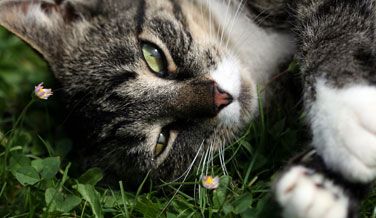PROVIDING QUALITY VETERINARY EYE CARE AT A FAIR COST
TO GIVE YOUR LOVED ONES A BETTER LIFE
Glaucoma
What is Glaucoma?
Glaucoma is defined as “an increase in pressure in the eye with a loss of vision.” The disease is painful in most cases, especially when the eye pressure is very high. The signs of glaucoma include: redness, cloudiness, tearing, loss of vision, an enlarged eyeball, unusual aggressiveness, lethargy, and loss of appetite. The normal physiology of the fluid in the eye calls for the fluid to be made in one structure behind the pupil (ciliary body), travel through the pupil, and exit out the space between the cornea and the iris. When the fluid cannot properly drain from the eye, the pressure in the eye is increased. An analogy would be a kitchen sink – if the drain is open and the water is running, there is no problem. However, if a plug is placed in the drain and the water keeps running, then the sink fills up with water and overflows! Some patients have primary glaucoma where there is no concurrent disease but some secondary causes of glaucoma include: inflammation, trauma, and tumors. All of these factors can obstruct the drainage of fluid from the eye.
Is it a Serious Condition?
Glaucoma is an ophthalmic emergency and must be treated immediately. If the pressure remains elevated for even a few hours, permanent vision loss occurs. The disease is difficult to treat but several options are available depending on whether the patient still has vision, the specifics of the patient, financial considerations, etc. Some of the options include: medical management with pills and eye drops, laser surgery to reduce the fluid production, injection of medication into the vitreous, surgically placed drainage tubes, and removal of the blind and painful eye. There are pros and cons to each of these treatments, and these variables will be discussed during the eye examination.
How is Glaucoma Treated?
Glaucoma treatment is complex and at times frustrating. Due to the complexity of the problem and the severity of the damage within the eye, the success of treatment is highly variable. Vision loss is unfortunately very common. Medical treatment usually requires the use of several drugs (eye drops and pills). Surgical treatment can either help reduce the need for medical treatment or in the case of some procedures eliminate the need for medical treatment completely.
If there is a chance of vision then the following is often recommended: medical treatment and consider laser surgery. If vision has been lost, then the recommendations may be to: remove the eye, place a silicone implant within the eyeball itself, or perform a chemical ablation.
Glaucoma cases usually need frequent follow-up care. If only one eye is involved, the other eye may need preventative treatment to delay or avoid glaucoma and subsequent vision loss.
Please feel free to ask further questions about glaucoma to our outstanding support staff.
Our Services
Our doctors will perform a complete eye examination on your pet with the assistance of our nurses. This includes examining the eye with a head set, hand lens, panophthalmoscope and slit lamp to aid in magnification of different parts of the eye.
Companion Animal Eye Registry
The purpose of the OFA Companion Animal Eye Registry (CAER) is to provide breeders with information regarding canine eye diseases so that they may make informed breeding decisions in order to produce healthier dogs.
Contact Us
Learn more about any of the animal eye care services we offer and current availability.




